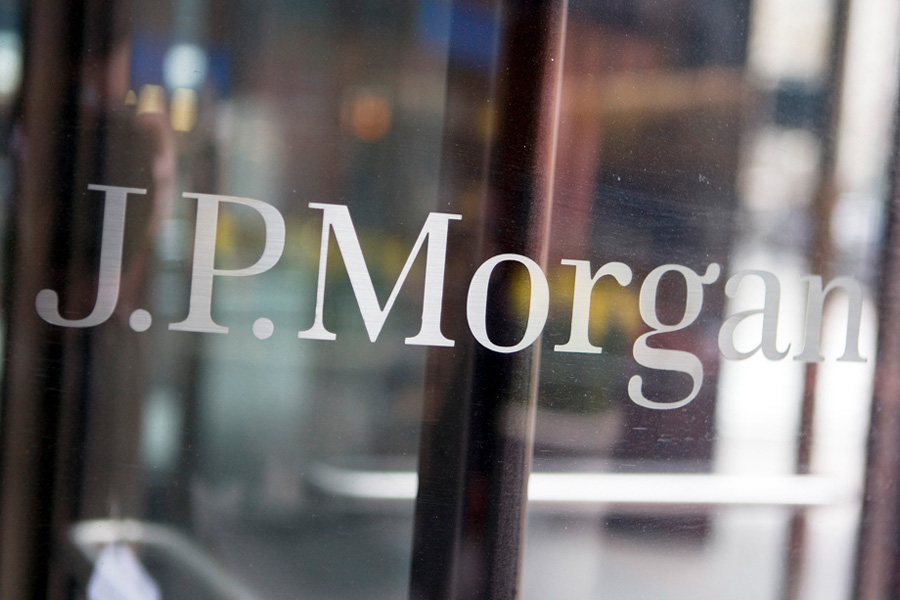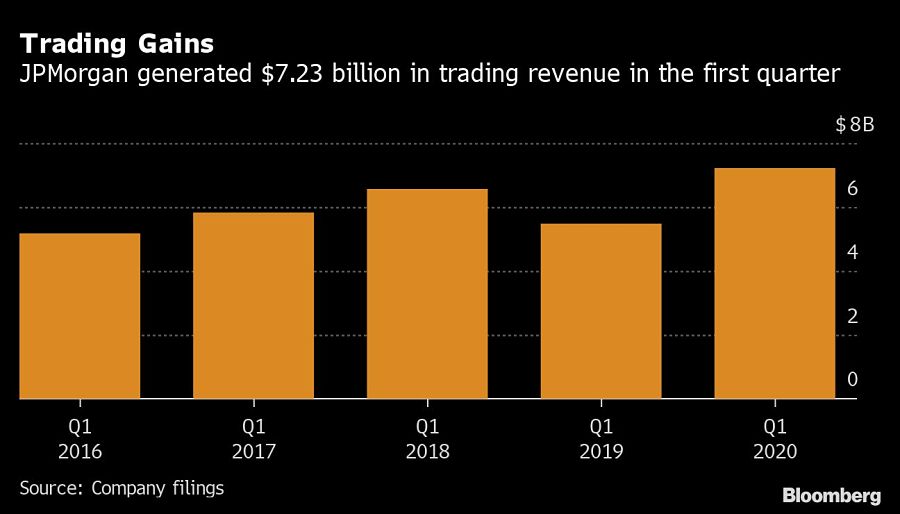

JPMorgan Chase & Co. said first-quarter profit tumbled 69% to the lowest level in more than six years as credit costs surged, giving investors a first glimpse at the extent of the damage Covid-19 is wreaking on bank results.
The company set aside $8.29 billion for bad loans, the biggest provision in at least a decade and more than double what some analysts expected, as it grappled with the effects of the coronavirus pandemic on the economy. That prompted JPMorgan’s first drop in profit since the fourth quarter of 2017.
Chief Executive Jamie Dimon warned earlier this month that the bank wouldn’t be immune to fallout from the pandemic, predicting in his annual letter to shareholders that the economy would suffer a “bad recession” and financial stress mirroring the 2008 financial crisis.
“Given the likelihood of a fairly severe recession, it was necessary to build credit reserves,” Dimon said in a statement Tuesday. “The first quarter delivered some unprecedented challenges and required us to focus on what we as a bank could do -- outside of our ordinary course of business -- to remain strong, resilient and well-positioned to support all of our stakeholders.”
The damage at JPMorgan hints at what’s to come when the rest of Wall Street reports results this week. Wells Fargo & Co. will reveal how it weathered the start of the pandemic later Tuesday, followed Wednesday by Bank of America Corp., Goldman Sachs Group Inc. and Citigroup Inc. Morgan Stanley’s announcement is scheduled for Thursday.
Some of the declines at JPMorgan were offset by gains in the bank’s trading operation, which benefited from record volatility during the quarter as investors moved in and out of positions in response to the unfolding crisis. The bank generated $7.23 billion from trading stocks and bonds, the most on record, according to data compiled by Bloomberg.

The trading gains came off a wild three months for the markets, with stocks reaching record highs in January only to suffer the biggest decline since the 1987 crash as the extent of the pandemic started to become clear.
Equities traders generated a record $2.24 billion in the quarter, 28% more than a year earlier, driven by derivatives. Bond-trading revenue rose 34% to $4.99 billion, the highest in nine years.
Revenue and profit fell in all but one of the bank’s four major business lines, driven by a 95% drop in net income in the massive consumer unit as the division set aside $5.77 billion of provisions for credit losses. The unit generated $191 million in profit.
The corporate and investment bank, which houses the trading and banking businesses, was the most profitable unit, earning $1.99 billion, or 39% less than last year. The asset and wealth management unit was the only division to see revenue rise, up 3% from last year’s first quarter.
JPMorgan shares rose 1.6% in early trading at 7:49 a.m. in New York. The stock fell 30% this year through Monday.
Consumer business
The bank on Tuesday lowered its full-year outlook for net interest income -- revenue from customers’ loan payments minus what the bank pays depositors -- by $1.5 billion to $55.5 billion. The revenue source accounted for about half the company’s total last year, and in the past has helped counter more volatile results in the trading and investment-banking divisions.
The crisis is still relatively new, and net charge-offs actually fell from the fourth quarter. But the bank increased its loan-loss reserve by more than $11 billion as it braced for higher credit-card defaults and saw corporate borrowers tap $50 billion worth of existing credit lines. The total allowance for possible loan losses rose to $25.4 billion, the highest since 2012, boosted by a $4.3 billion increase from new rules the bank had previously announced and a $6.8 billion reserve build.
JPMorgan and other banks adopted a new accounting standard this year known as CECL, which aims to push banks to set aside provisions earlier in a cycle.
The Federal Reserve had two emergency rate cuts, bringing the central bank’s benchmark to virtually zero. The action came as more evidence emerged that the U.S. economy was being hit hard by the virus and the global economic shutdown.
For its part, JPMorgan has been waiving fees for some loans, allowing customers to defer payments on mortgages and auto loans, and removing minimum payment requirements on credit cards. It’s planning to lend an additional $150 billion to clients across the world.
KBW analysts led by Brian Kleinhanzl said in an April 8 report they expect provisions to peak in the second quarter as banks build reserves in advance of expected charge-offs under the newly adopted CECL accounting rules.
Investors and analysts are taking comfort in the fact that banks are entering the uncertain period with higher capital levels than they had during the 2008 financial crisis.
“The company entered this crisis in a position of strength, and we remain well capitalized and highly liquid - with a CET1 ratio of 11.5% and total liquidity resources of over $1 trillion,” Dimon said in the statement.
While the results offer a look at the impact of the virus, the picture is somewhat muddled because they include January and February, before government lockdown measures began in earnest. Analysts are expecting future quarters to show even more damage to consumer businesses as near-zero interest rates and rising unemployment take a toll.
Analysts at Jefferies Financial Group warned before earnings were released that traditional credit metrics would be thrown off by “forbearance programs aimed at limiting long-term effects on the economy,” such as the payment deferrals JPMorgan has offered on consumer loans.

Relationships are key to our business but advisors are often slow to engage in specific activities designed to foster them.

Whichever path you go down, act now while you're still in control.

Pro-bitcoin professionals, however, say the cryptocurrency has ushered in change.

“LPL has evolved significantly over the last decade and still wants to scale up,” says one industry executive.

Survey findings from the Nationwide Retirement Institute offers pearls of planning wisdom from 60- to 65-year-olds, as well as insights into concerns.
Streamline your outreach with Aidentified's AI-driven solutions
This season’s market volatility: Positioning for rate relief, income growth and the AI rebound
